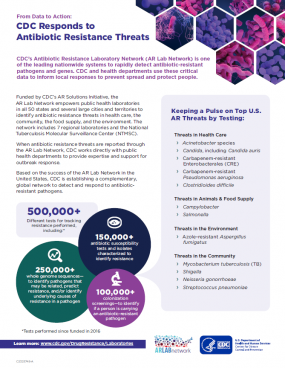Lab Capacity in Action to Fight Antimicrobial Resistance
Laboratory tests can help guide patient treatment, detect emerging threats, and prevent the spread of antimicrobial resistance. CDC’s antimicrobial resistance laboratory networks support lab testing in health care, the community, and the environment (e.g., water, soil). This work ultimately improves patient care, enhances public health, and informs solutions against resistance threats.
CDC implements activities outlined in the U.S. National Action Plan for Combating Antibiotic-Resistant Bacteria, released in 2015 and 2020. These activities are funded through CDC antimicrobial resistance investments, collectively known as CDC’s Antimicrobial Resistance (AR) Solutions Initiative. Through these investments, CDC is transforming how the nation combats antimicrobial resistance.
CDC Activities
Closing Data Gaps
- Closing the gap between local capabilities and the data needed to combat antimicrobial resistance by providing:
- Comprehensive lab capacity and infrastructure for antimicrobial-resistant germs
- Cutting-edge technology, like whole genome sequencing
- Data to drive response and prevent infections
- Adding new lab samples and isolates (pure samples of a germ) to CDC and FDA AR Isolate Bank to support researchers in developing new diagnostics and more treatment options
Coordinating a Unique National Network
- Supporting nationwide lab capacity through CDC’s Antimicrobial Resistance Laboratory Network (AR Lab Network) to detect antimicrobial resistance rapidly and inform local responses to prevent spread and protect people
- Coordinating the AR Lab Network and providing technical expertise
- Collaborating with the seven regional labs, which coordinate and complement activities done at the local and state level
- Working across the different labs to support outbreak response and create tailored solutions
- Coordinating the AR Lab Network and providing technical expertise
Additional Work in Progress
- Establishing CDC’s Global AR Lab and Response Network, a global network to improve the detection of existing and emerging antimicrobial resistance threats outside of the U.S.
- Growing to include new threats as they emerge, including Candida auris and Aspergillus fumigatus
Examples of CDC Activities in Action
- Since 2016, CDC’s AR Lab Networks have tested
- More than 100,000 colonization screenings to identify if a person is carrying a resistant germ
- More than 250,000 whole genome sequences to identify germs that may be related, to predict resistance, or to identify underlying causes of resistance in a germ
- More than 150,000 antibiotic susceptibility tests and isolates characterized to identify resistance
- Since 2011, CDC’s Antibiotic Resistance Lab Network sequenced nearly 38,000 gonorrhea and tuberculosis isolates, identifying threats before they spread
